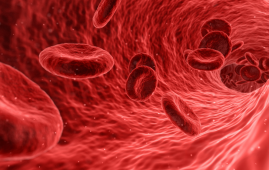

Weill Cornell Medicine researchers found a technique that ovarian cancers exploit to disable immune cells and hamper their attack: limiting the energy supply that T cells rely on. The study, published on Oct. 23 in Nature, suggests a promising new immunotherapy approach for ovarian cancer, which is notoriously aggressive and difficult to treat.
The tumor microenvironment—a complex ecosystem of cells, chemicals, and blood vessels that protects cancer cells from the immune system—poses a substantial challenge in treating ovarian cancer. In this hostile environment, T cells lose their ability to absorb lipid (fat) molecules, which are required for energy to launch a successful onslaught.
“T cells rely on lipids as fuel, burning them in their mitochondria to power their fight against pathogens and tumors,” explained senior author, Dr. Juan Cubillos-Ruiz, The William J. Ledger, M.D., Distinguished Associate Professor of Infection and Immunology in Obstetrics and Gynecology at Weill Cornell Medicine. “However, the molecular mechanisms that govern this critical energy supply are still not well understood.”
Identifying how tumors inhibit T cell energy supply
Although lipids are abundant in ovarian tumors, T cells appear to be unable to use them. “Researchers have focused on a protein called fatty acid-binding protein 5, or FABP5, which facilitates lipid uptake, but its exact location within the T cell remained unclear,” said Dr. Sung-Min Hwang, a postdoctoral associate in Dr. Cubillos-Ruiz’s lab who led the new study. Dr. Hwang revealed that in patient-derived tumor specimens and mice models of ovarian cancer, FABP5 is retained inside the cytoplasm of T cells rather than migrating to the cell surface, where it would typically assist take up lipids from the environment.
“That was the ‘aha!’ moment; since FABP5 is not getting to the surface, it couldn’t bring in the lipids necessary for energy production. But we still needed to figure out why.”- Dr. Cubillos-Ruiz, Cancer Biology Program, Sandra and Edward Meyer Cancer Center, Weill Cornell Medicine
Working with partners, the researchers performed a battery of biochemical experiments to identify proteins that bind to FABP5. They discovered Transgelin 2, a protein that interacts with FABP5 and helps it travel to the cell’s surface.
Further research discovered that ovarian cancers inhibit the synthesis of Transgelin 2 in invading T cells. Further investigation revealed that the transcription factor XBP1, which is triggered by the tumor’s stressful circumstances, represses the gene that encodes Transgelin 2. Without Transgelin 2, FABP5 becomes stuck in the cytoplasm of T cells, inhibiting lipid uptake and rendering the T cells incapable of attacking the tumor.
Designer immunotherapies to overcome cancer defenses
With this essential mechanism established, the scientists investigated an immunotherapy known as chimeric antigen receptor T (CAR T) cells. This method takes a patient’s T cells, genetically designs them to attack tumor cells, and then injects the designer cells into the patient. “CAR T cells work well against hematological cancers like leukemia and lymphoma, but they’re really not effective for solid tumors like ovarian or pancreatic cancers,” says Dr. Cubillos-Ruiz.
When Dr. Hwang and his colleagues examined CAR T cells, which are now being studied in clinical trials, in mice models of metastatic ovarian cancer, they discovered the same issue: transgelin 2 suppression and decreased lipid uptake. FABP5 was knotted in the cytoplasm of manufactured CAR T cells, just as it is in normal T cells in the tumor microenvironment. As a result, CAR T cells were unable to access lipids for energy, underlining a key hurdle to employing this immunotherapy to treat solid tumors such as ovarian cancer.
To address the issue, the researchers inserted a modified Transgelin 2 gene that could not be inhibited by stress transcription factors, preserving expression of the crucial protein. This enabled Transgelin 2 to chaperone FABP5 to the surface of CAR T cells, where it could absorb lipids.
Indeed, the enhanced T cells were far more effective at destroying ovarian cancers than the initial CAR T cells. “Our findings reveal a key mechanism of immune suppression in ovarian cancer and suggest new avenues to improve the efficacy of adoptive T cell immunotherapies in aggressive solid malignancies,” said Cubillos-Ruiz’s doctor.
For more information: Transgelin 2 guards T cell lipid metabolism and antitumour function, Nature, https://doi.org/10.1038/s41586-024-08071-y
more recommended stories
 Fat-Regulating Enzyme Offers New Target for Obesity
Fat-Regulating Enzyme Offers New Target for ObesityKey Highlights (Quick Summary) Researchers identified.
 Spatial Computing Explains How Brain Organizes Cognition
Spatial Computing Explains How Brain Organizes CognitionKey Takeaways (Quick Summary) MIT researchers.
 Gestational Diabetes Risk Identified by Blood Metabolites
Gestational Diabetes Risk Identified by Blood MetabolitesKey Takeaways (Quick Summary for Clinicians).
 Phage Therapy Study Reveals RNA-Based Infection Control
Phage Therapy Study Reveals RNA-Based Infection ControlKey Takeaways (Quick Summary) Researchers uncovered.
 Pelvic Floor Disorders: Treatable Yet Often Ignored
Pelvic Floor Disorders: Treatable Yet Often IgnoredKey Takeaways (Quick Summary) Pelvic floor.
 Urine-Based microRNA Aging Clock Predicts Biological Age
Urine-Based microRNA Aging Clock Predicts Biological AgeKey Takeaways (Quick Summary) Researchers developed.
 Circadian Control of Neutrophils in Myocardial Infarction
Circadian Control of Neutrophils in Myocardial InfarctionKey Takeaways for HCPs Neutrophil activity.
 E-Cigarette Use and Heart Attack Risk in Former Smokers
E-Cigarette Use and Heart Attack Risk in Former SmokersKey Takeaways for Clinicians and Nurses.
 36-Week Pre-eclampsia Screening May Reduce Term Risk
36-Week Pre-eclampsia Screening May Reduce Term RiskA New Preventive Strategy for Term.
 Cardiovascular Risk and Sudden Cardiac Death in Diabetes
Cardiovascular Risk and Sudden Cardiac Death in DiabetesRising Sudden Cardiac Death (SCD) Risk.

Leave a Comment